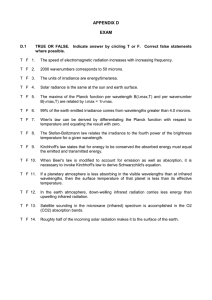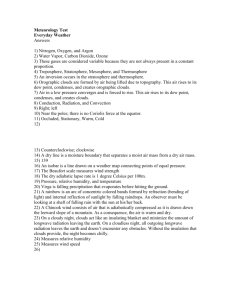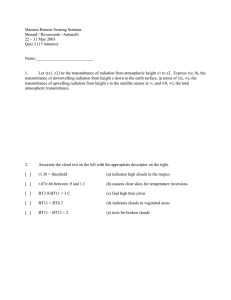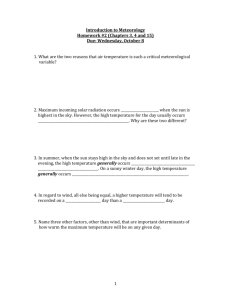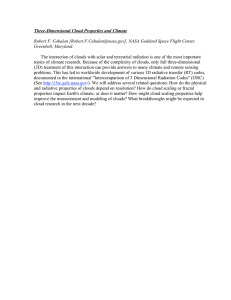APPENDIX D Exam
advertisement
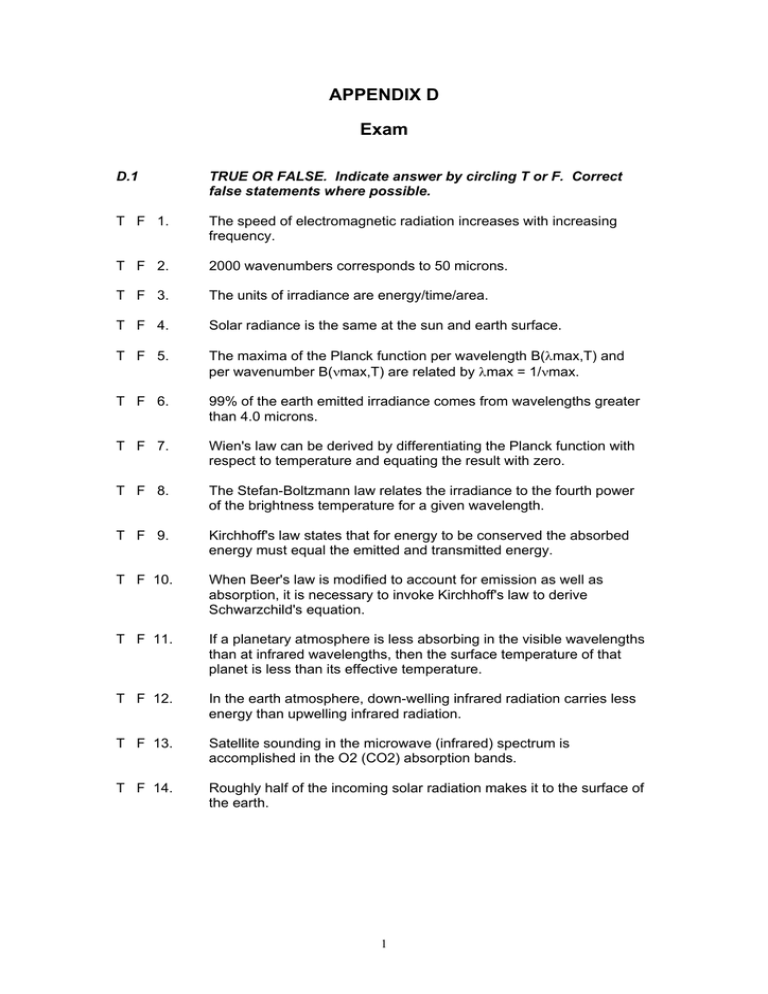
APPENDIX D Exam D.1 TRUE OR FALSE. Indicate answer by circling T or F. Correct false statements where possible. T F 1. The speed of electromagnetic radiation increases with increasing frequency. T F 2. 2000 wavenumbers corresponds to 50 microns. T F 3. The units of irradiance are energy/time/area. T F 4. Solar radiance is the same at the sun and earth surface. T F 5. The maxima of the Planck function per wavelength B(λmax,T) and per wavenumber B(νmax,T) are related by λmax = 1/νmax. T F 6. 99% of the earth emitted irradiance comes from wavelengths greater than 4.0 microns. T F 7. Wien's law can be derived by differentiating the Planck function with respect to temperature and equating the result with zero. T F 8. The Stefan-Boltzmann law relates the irradiance to the fourth power of the brightness temperature for a given wavelength. T F 9. Kirchhoff's law states that for energy to be conserved the absorbed energy must equal the emitted and transmitted energy. T F 10. When Beer's law is modified to account for emission as well as absorption, it is necessary to invoke Kirchhoff's law to derive Schwarzchild's equation. T F 11. If a planetary atmosphere is less absorbing in the visible wavelengths than at infrared wavelengths, then the surface temperature of that planet is less than its effective temperature. T F 12. In the earth atmosphere, down-welling infrared radiation carries less energy than upwelling infrared radiation. T F 13. Satellite sounding in the microwave (infrared) spectrum is accomplished in the O2 (CO2) absorption bands. T F 14. Roughly half of the incoming solar radiation makes it to the surface of the earth. 1 The earth-atmosphere spectrum for a given scene is depicted in the figure below: T F 15. The ordinate (y-axis) is radiance in mW/ster/m2/cm-1. T F 16. The absorption band centers for CO2, O3, and H2O appear near abscissa values of 650, 1050, and 1600 respectively. T F 17. The plateau between abscissa values 1100 and 1200 is a window region of the atmosphere. T F 18. The dip at the abscissa value of roughly 800 is the location of the dirty window. T F 19. In this scene, clouds are affecting the 1100 to 1200 region of the spectrum more than the 900 to 1000 region. T F 20. The tropopause temperature for this scene is roughly 220 K. T F 21. The split window temperature difference is about 10 K in this scene. T F 22. At the band center of abscissa value 700, the little peak is a result of warming with altitude in the stratosphere. T F 23. At the band center of abscissa value 1050, the little peak is the result of O3 absorption in the stratosphere. T F 24. Instrument noise for the 500 to 600 part of the spectrum is about 5 K. T F 25. The jagged peaks are the result of rotational absorption bands. 2 When a cloud at a single level is obscuring the instrument field-of-view, the radiance detected by the satellite infrared radiometer is represented by: Iλcd pc = (1-ελ)Bλ(Ts)τλ(ps) + (1-ελ) ∫ Bλ(T(p))dτλ ps o + ελ Bλ(T(pc))τλ(pc) + ∫ Bλ(T(p))dτλ, pc T F 26. The first two terms are radiative contributions from below the cloud that make it to the top of the atmosphere. T F 27. The last term represents radiation absorbed by the atmosphere Above the cloud and thus not making it to the top of the atmosphere. T F 28. The third term is the radiative contribution of the cloud itself that makes it to the top of the atmosphere. T F 29. The first term is negliglible for radiation at 14.0 mm. T F 30. ελ is the earth surface emissivity. The Earth atmosphere radiation budget measurements from satellite indicate that T F 31. The distribution of sunlight with latitude is responsible for our major climatic zones. T F 32. The net radiation for the earth varies throughout the year in accordance with the earth-sun distance. T F 33. The solar constant is between 1260 and 1280 W/m2. T F 34. The albedo and longwave radiation cycles are roughly in phase. T F 35. Scattering of terrestrial radiation by the atmospheric constituents is relatively insignificant with regard to the global energy balance. T F 36. During December, the outgoing longwave radiation from the earth atmosphere is at a minimum because snow and cloud cover are at a maximum in the northern hemisphere. T F 37. Outgoing longwave radiation increases with cloudiness. T F 38. Earth radiation budget studies have shown that global averages of outgoing terrestrial radiation are in phase with absorbed solar energy on an annual cycle. T F 39. Reflected sunlight contributions to the radiance measured at 4.0 um 3 limits the usefulness of such measurements for daylight sea surface temperature determinations. T F 40. SST determinations rely on alleviating the influence of clouds with split window infrared observations and accounting for the effects of atmospheric water vapor with the longwave and shortwave infrared window observations. T F 41. The correction for atmospheric water vapor attenuation in atmospheric windows requires knowledge of the atmospheric water vapor profile. T F 42. As cloud amount varies (for a single layer of high cloud), the radiance observed in the 11 micron window is linearly related to the radiance observed in the 6.7 micron channel. T F 43. If the brightness temperature difference 4 micron less 11 micron is greater than 3 K, then the field-of-view is either mostly cloudy or mostly clear. T F 44. In polar regions, if the brightness temperature at 6.7 microns is warmer than that at 11.0 microns, then the FOV is probably clear. T F 45. The moisture sensitive channel at 1.38 microns sees cirrus as well as lower stratus clouds. T F 46. For ice clouds Tb13 ~ Tb11 and Tb11 >> Tb8.6, while for water clouds Tb13 > Tb11 and Tb11 ~ Tb8.6. T F 47. Broken clouds within a pixel produce Tb11 < Tb4 for the same reason subpixel fires produce Tb4 > Tb11. T F 48. Threshold brightness temperature tests for clouds using the infrared window are complicated by atmospheric moisture variations and non unit surface emissivity for various bio-regimes. T F 49. As atmospheric moisture increases, Tb11-Tb12 increases while Tb8.6-Tb11 decreases. T F 50. Vertical wind shear can be derived from horizontal temperature gradients using the thermal wind equation. T F 51. Tropical cyclone intensity can be inferred from microwave brightness temperatures gradient between the eye of the storm and the stable surrounding environment. A 10 C gradient implies a pressure drop in the eye of about 5 mb. T F 52. A column of rain cooler than the earth surface increases the observed brightness temperature in the microwave window over the rain free value. Regarding geostationary and polar orbiting satellites indicate which characteristic is true for that instrument platform 4 G P 53. Observes the process itself rather than the effects of the process. G P 54. Measures spatial gradients of temperature and moisture. G P 55. Measures radiances in differing solar illuminations. G P 56. Microwave helps with sounding in clouds. G P 57. Offers best viewing of the tropics. G P 58. Used to infer cloud drift winds. G P 59. Evolved on Nimbus series of satellites. G P 60. Has orbital period of 24 hours. G P 61. Used to infer vegetation index. G P 62. NOAA launched AMSU into this orbit. D.2. SHORT PROBLEMS (allow 15 minutes per problem) 1. The Planck (P) function is given by B(λ,T) = 5 c2/λT c1 / [λ (e - 1)] (a) What is the Rayleigh Jeans (RJ) expression, valid in the long wavelength region of the spectrum? (b) Using c2 = 1.4 cm K, estimate (BP - BRJ) / BP for λT = 100 cm K. Keep second order terms for BP and only first order terms for BRJ. 2. If the CO2 concentration in the atmosphere is doubled, the net additional heating of the earth surface and the troposphere has been calculated to be 4 W/m2 (which is the negative net change in outgoing radiative flux density or irradiance at the tropopause). Using the Stefan-Boltzmann law and assuming that the effective temperature of the earth-atmosphere system is 280 K before the CO2 doubling, determine the associated temperature change of the earth-atmosphere system. 3. Venus is 25% closer to the sun than the earth (Rvs = .75Res). Its effective temperature is 230 K compared to 255 K for the earth. If the earth albedo is 30%, what is the albedo of Venus? 4. Consider an atmosphere where the temperature profile is given by T(p) = 200 + 100 (p/ps) in degrees K. The transmittance for a microwave spectral band is given by τ(p) = 1.0 - 0.7 (p/ps) . Assuming reflection is negligible at the earth surface, what is the brightness temperature observed by the microwave sensor in this spectral band? Start with the RTE to develop your answer. 5. A hot plume of industrial waste is obstructing the view of an infrared radiometer into the distance. Thus the radiometer senses a hotter temperature. What is the difference of the radiances sensed by the radiometer when viewing a clear FOV and 5 then a plume contaminated FOV? Use the indicated transmittances and radiances for background, plume, and foreground to calculate your answer. background plume foreground temperature (degrees Kelvin) Tb = 300 Tp = 340 Tf = 300 bb radiance (mW/m2/ster/cm-1) Bb = 115 Bp = 195 Bf = 115 transmittance τb = 0.9 τp = 0.3 τf = 0.9 6. Two window channels (11 and 12 microns) are viewing the ocean in cloud free conditions. The observed brightness temperatures are 297 K and 293 K. The respective atmospheric transmittances are .97 and .94. (a) What is the ratio of the absorbing powers kw11/kw12? (b) What is the SST? 7. In a cloud free region over the ocean, the infrared window is being used to estimate sea surface temperature. If volcanic ash of .02 optical thickness in the longwave infrared window and temperature Tc = 220 K obscures the ocean, what error is introduced to the sea surface temperature estimate Ts = 300 K? Express the transmittance of the volcanic ash τ = 1-σ, and use the fact that at 900 cm-1 the 4 Planck radiance is proportional to T . 8. There is a low layer of mist at 290 K obscuring ocean at 300 K. A radiometer in the microwave window is measuring sea surface temperature (SST). What error does the mist introduce to the SST? Assume that the emissivity of sea water εs is .5, the optical thickness of the mist σm is .02. Use σm = εm = 1-τm. Include the contributions to the radiometer from the surface, the mist, and the surface reflection. 9. Assume that a two channel radiometer is viewing broken clouds. One channel is the longwave infrared window channel and it measures energies of 24 and 60 units from adjacent fields of view. The other channel is a CO2 sensitive channel and it observes 36 and 90 units of energy respectively from the same two fields of view. A nearby cloud free measurement in the window channel has 108 units of energy. (a) What is the cloud free value of the CO2 channel observation? (b) If one of the fields of view is completely filled with clouds, what is the percentage cloud cover in the other field of view? 10. A radiometer sensitive in the short wave IR window (ν=2500cm-1) is viewing a 300 K scene when a 600 K fire starts. What fraction of the field of view must be on fire to increase the observed brightness temperature by 1% (3 K)? Use the fact that B(2500 cm-1,T) ~ T12. 11. A histogram of frequency versus infrared window brightness temperature is tabulated over a portion of the Indian Ocean. A least squares fit of the normal distribution probability function at the warm end of the histogram yields ln f = -10272.7 + 70.2T - 0.12T2. What is the SST? Show how you arrive at your answer. 6 12. A window channel microwave radiometer (τ = 1 throughout the atmosphere in the absence of clouds) is viewing a cloud at 400 mb (with εc = .3, Tc = 240 K) over the earth surface (with εs = 1.0, Ts = 300 K). Assuming a uniform lapse rate of 10 degrees per 100 mb, what is the observed microwave window brightness temperature? 13. A radiometer is viewing broken clouds. The window channel brightness temperature suggests clouds at 500 mb. The CO2 slicing technique indicates clouds at 400 mb. Estimate the effective emissivity of the clouds in the fov. Use data in the following table to derive your answer. P 1000 850 700 600 500 400 300 200 100 T 279 275 266 260 252 244 230 218 214 B11.2 85.3 79.8 68.0 60.7 51.8 43.8 31.7 23.3 20.8 Pc - ∫ τ(11.2) dB(11.2) Ps 0.00 5.23 16.71 23.88 32.68 40.64 52.60 60.95 63.37 14. The thermal wind equation says (∆v/∆z) = (g / f / Tav)*(∆T/∆x). At one km height the wind is 10 m/s and the VAS measures a temperature gradient of 3 K over 100 km. Infer the wind at 2 km height. Use (g / f / Tav) = 400 m/s/K. 7
